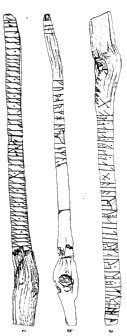The Greenland Runes
Greenland was populated by
settlers from Iceland and Norway from 985 or 986 A.D. The leader of the
first group of settlers was Eirik Raude, the father of Leif Eiriksson. (Leif
Eiriksson later discovered Vinland, hence North America). The group set out
from Iceland with 25 ships, but only 14 ships arrived at Greenland. The rest
of the ships were either wrecked in storms when they crossed the sea or
turned back to Iceland. The settlers brought with them the Norse manner of
living, as well as the runes. These people lived on Greenland for 500 years,
until they mysteriously disappeared from history. Today, the only trace of
them are the ruins they left behind.
 Approximately
60 runic inscriptions have been found on Greenland. Approx. 35 of these
inscriptions have been discovered in Austerbygden, one inscription (see
picture) has been found on the isle of Kingigtorssuaq (far north of the
populated area) and approx. 20 inscriptions have been discovered in
Vesterbygden. (Helge Ingstad, 1959,1995)
Approximately
60 runic inscriptions have been found on Greenland. Approx. 35 of these
inscriptions have been discovered in Austerbygden, one inscription (see
picture) has been found on the isle of Kingigtorssuaq (far north of the
populated area) and approx. 20 inscriptions have been discovered in
Vesterbygden. (Helge Ingstad, 1959,1995)
 The
oldest runic inscriptions found on Greenland are written on a piece of wood
found at Narssaq, north-east of Julianehåb. There is reason to believe that
these runes, inscribed on three sides of the wood, were written in the
beginning of the 11th century.
The
oldest runic inscriptions found on Greenland are written on a piece of wood
found at Narssaq, north-east of Julianehåb. There is reason to believe that
these runes, inscribed on three sides of the wood, were written in the
beginning of the 11th century.
On one side a complete 16 rune Futhark of the older type of short twig runes
is written. However, two of the runes on this piece of wood have a typical
design created in Greenland; the B- and R- rune. (These older, shorttwig-runes
went out of use in Norway about 1000 A.D. Thereafter, the newer type of
shorttwig-runes were used in Norway.)
On the second side of this piece of wood there is runic text which states:
"Bibrau is the name of the girl who sits in the blue."
On the third side there is written a secret, magical formula which is
untranslatable. (Erik Moltke,1959).
The second oldest inscription which has been found is probably from the 13th
century. It is etched on a headstone in a churchyard cemetery. The
inscription says: "Ingibjorg's grave".
All other runic inscriptions which have been found probably date to
approximately the 14th century.
A characteristic of the language used in Greenland was that it was very
conservative. The older forms of speaking, which had come from Iceland and
Norway, were kept intact. (It must be acknowledged that they were also
independent and created new dialects). In keeping with this conservatism,
the Greenlanders likewise maintained the older runic characteristics, most
of which had fallen out of use in other countries. Notwithstanding this,
they created new designs for the ð-, b-, p- and r-runes. (Magnus Olsen).
By 1300 A.D. the common language used in Greenland and Iceland had diverged,
as it did in the Faeroe Islands, Shetland Islands, Orkeny Islands, and the
Hebrides. As a result of this development in regional language, including
Norway, many disparate West-Norwegian and Norwegian dialects emerged.
(Magnus Olsen).
Runic inscriptions were often written on articles of everyday use, such as
graveyard stones, wooden crucifixes, etc. One runic inscription found upon a
piece of wood within a coffin at the graveyard of Hrjolfsnes says: "This
woman, whose name is Gudveig, was buried at sea in the Greenland Sea".
In this way, she was finally paid the respect of being commemorated at a
holy site.
ABOUT RUNES IN THE LITERATURE
Bjørn Jónssons has written about Lik-Lodin (= Corpse-Lodin), who lived
around the middle of the 11th century. In the summertime Lik-Lodin used to
sail north of the populated areas and bring home shipwrecked seamen or
hunters who had died out on the drifting ice. He often found their bodies in
caves and clefts, and sometimes he found runic inscriptions telling what had
become of the dead men.
In the Sturlungasaga you can read about the priest Ingmund, whose
ship was wrecked upon east Greenland. His remains were found in a cave.
Beside him were the runes which told of the fate which had befallen him. The
runes were written on a "vaxspjald".
 "Vaxspjald" is a type of hand held writing board which
consisted of a piece of wood with one surface covered in wax (see picture).
The runes were scratched in the wax. It was possible to erase the message by
smoothing out the wax surface before writing a new message on the "vaxspjald".
A "vaxspjald" has been found at the Hopperstad stave church
in Norway.
"Vaxspjald" is a type of hand held writing board which
consisted of a piece of wood with one surface covered in wax (see picture).
The runes were scratched in the wax. It was possible to erase the message by
smoothing out the wax surface before writing a new message on the "vaxspjald".
A "vaxspjald" has been found at the Hopperstad stave church
in Norway.
Copyright of Arild Hauge © Norway, Oslo 2000